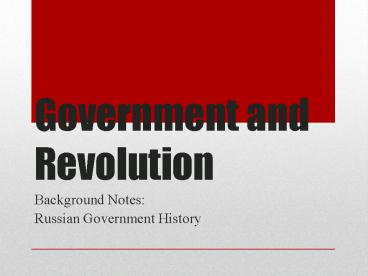Government and Revolution - PowerPoint PPT Presentation
1 / 14
Title:
Government and Revolution
Description:
Government and Revolution Background Notes: Russian Government History Romanovs Nicholas II: The Last Emperor Married Alexandra (German princess; granddaughter of ... – PowerPoint PPT presentation
Number of Views:86
Avg rating:3.0/5.0
Title: Government and Revolution
1
Government and Revolution
- Background Notes
- Russian Government History
2
Romanovs
3
Nicholas IIThe Last Emperor
- Married Alexandra (German princess granddaughter
of Englands Queen Victoria) - Four daughters, then son (Alexei)-had hemophilia
- Rasputin peasant pilgrim, mystic believed by
Alexandra to have healing power on son held
power over Alexandra
4
- Rasputin
5
Beginning of The EndBloody Sunday
- 1905 Revolution
- Russia was involved in the Russo-Japanese War,
and they were clearly losing, the war and
government support - In January 22, 1905, a group of workers marched
to the czars Winter Palace in St. Petersburg to
make their demands. Imperial forces opened fire
on the demonstrators, killing and wounding
hundreds. Strikes and riots broke out throughout
the country in outraged response to the massacre,
to which Nicholas responded by promising the
formation of a series of representative
assemblies, or Dumas, to work toward reform. - The Duma had little power in reality, and not
much changed.
6
The Revolution Builds Strength
- Russia enters the First World War
- 1915 - Following failures in the war, Tsar
Nicholas II decided in September to assume
control of the armed forces. The result of this
decision was to remove Nicholas from the
political center of Russia and make decision
making and policy implementation incredibly
difficult.
7
Its All Over Now Homes
- 1917- February. St Petersburg (Petrograd). Cold
weather and food shortages led to outbreaks of
violence as starving workers rioted and broke
into shops and stores. - In March, 1917, a Provisional Government was
established in St Petersburg (Petrograd). The
Provisional Government intended to continue the
war effort but wanted to govern the country in a
different way, led by Kerensky. - Tsar Nicholas II was at the front when this was
done. As he tried to return to St Petersburg to
deal with the situation his train was stopped by
troops loyal to the new Provisional Government
and, on 15th March he was forced to abdicate.
8
Communism Takes Control
- November 1917 Bolshevik Revolution, Led by
Vladimir Lenin. Because the Provisional
Government stayed in the war, the people didnt
fully support them, and Lenin and his Bolshevik
Party took control of Russia (minute 24-26 in
documentary). - Peace, Bread, and Land
- As Lenin attempted to gain control over the whole
country, forces loyal to the Tsar or that were
anti-communist gathered strength to oppose him.
This created a three-year civil war over control
of the Russian state. - The forces led by Lenin and the Bolsheviks were
called the Reds, (red has been the color of
revolution since the French Revolution) while
forces opposed to him where termed White (white
has traditionally been the color of royalty).
9
Long Live The Party
- The Red Army was able to defeat the much larger
White armies over the course of the three-year
conflict. The Red Army was led by fanatical
communists who were prepared to do what ever was
necessary to preserve the revolution - Lenin saw the need to stabilize the government
and country by eliminating people who did not
support the revolution. This period became known
as the Red Terror. - During the terror, Lenin had people inside and
outside of the party eliminated to ensure the
success of the communist takeover (the Bolsheviks
changed their name to the Communist Party in
1918). Thousands of people disappeared during the
purge, but the plan helped control the opposition
to the Communist Party.
10
(No Transcript)
11
Lenin To Stalin
- Lenin was the leader of the party, Trotsky and
Stalin were his next in line. - Trotsky was far more popular than Stalin, and was
gifted at rallying support and speaking
passionately to the masses. Stalin was better at
backdoor deals, and shaking the right hands,
building loyalty within the Communist Party. - Lenin died January of 1924. Lenin hoped for
shared power between Stalin and Trotsky. - By 1927, Stalin had effectively eliminated all of
his political rivals (Exiled Trotsky and
eventually had him assassinated in Mexico) to
emerge as the head of the Communist Party of the
Soviet Union. - Cruel leader
- Removed anyone he didnt trust
- Sent to labor camps
- 1934- 2/3 of Central Committee executed
- 1937-1938 1 million people shot 2 million died
in camps (Purges)
12
Stalins Relationship with Hitler
- Initial cooperation
- Nazi expansion Stalin sought alliance w/France
England - Secret negotiations w/Germany
- Continued anti-German talks w/Allies
- Signed non-aggression pact w/Hitler (possible
expansionist thoughts for himself), shocking
Allies
13
- 1939 Germany invades Poland (begins WWII)
- Stalin invades Poland from East
- Stalin deports thousands of Poles to Siberia
- Stalin takes Finland and parts of Baltic
- June 22, 1941 Germany invades USSR
14
Post War USSR
- Stalin dies 1953
- Kruschev
- Breshnev
- Gorbechev
- Communist rule collapses in 1991 primary
surviving state Russia































